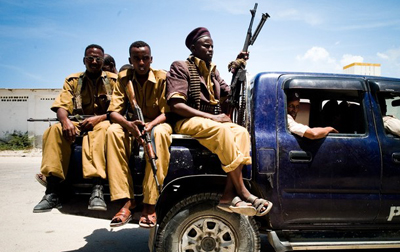Nairobi, July 2, 2010—Somali government forces have been increasingly harassing independent journalists covering violent fighting in Mogadishu, the Committee to Protect Journalists said today.
Somali reporters targeted for their reporting included a New York Times correspondent and a CPJ International Press Freedom Award winner, while nine other journalists were injured this week while reporting during deadly clashes between government troops and Islamist rebels, according to news reports and CPJ interviews.
On Thursday, police detained award-winning journalist Mustafa Haji Abdinur and freelance cameraman Yusuf Jama Abdullahi for taking pictures of their colleague, Associated Press photojournalist Farah Abdi Warsame, who had been hit by crossfire, according to the National Union of Somali Journalists (NUSOJ). Officers at the Criminal Investigation Department interrogated the journalists for several hours and forced them to delete their photographs, Abdinur told CPJ. They were released without charge. Warsame was rushed to Medina Hospital for shrapnel wounds in his hand and back, and is now recovering at home, according to NUSOJ.
Last week, New York Times correspondent Mohammed Ibrahim fled the country following threats from government security forces, he told CPJ. Ibrahim had contributed reporting to a June 13 New York Times article, “Children Carry Guns for a U.S. Ally, Somalia,” concerning child soldiers within the government forces.
“The reaction of the Somali government to these very serious allegations is both frightening and typical,” said CPJ East Africa Consultant Tom Rhodes, who is based in Nairobi. “Instead of addressing this very serious issue, security forces are persecuting reporters. Journalists must be allowed to do their job.”
In response to the story, the deputy commander of the Somali military, Adbdulkarim Yusuf Adam, held a June 24 press conference in which he accused those involved in publishing the article of having ties with terrorist organizations, local journalists told CPJ. Adam also declared that all individuals involved—whether foreign or local—would be taken to court, according to the same sources. Government spokesman Abdi Kadir Walayo claimed the article had been fabricated in a June 29 Voice of America interview.
Ibrahim said he received a warning from a friend while at a local restaurant last week that security forces were coming to arrest him, and later heard that more than 20 police officers came to the restaurant after he left. The journalist went into hiding and fled the country on June 26.
The government’s director of communications, Abdirashid Hashi, told CPJ that Ibrahim is “a good friend” and should contact him in order to settle the matter with the security forces.
Somalia is the most dangerous country in Africa to be a journalist, with 33 journalists killed since 1993. The most recent killing was in May, when gunmen shot Radio Mogadishu journalist Sheik Nur Mohamed Abkey outside his home in the capital.
